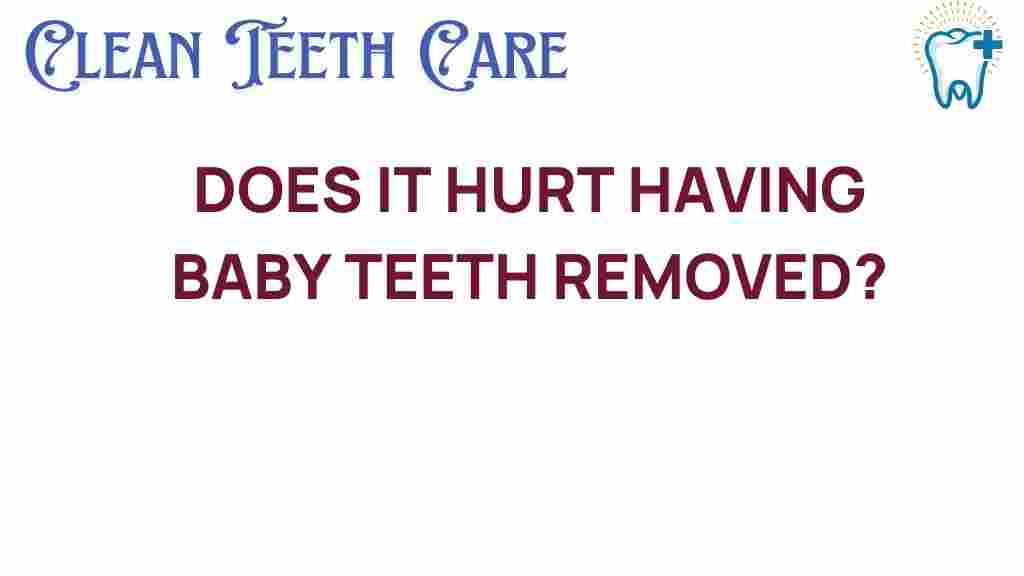The Truth About Baby Teeth Removal
When it comes to children’s health, many parents have questions regarding dental procedures, especially concerning baby teeth removal. As children grow, their baby teeth naturally become loose and eventually fall out, making way for permanent teeth. However, there are instances where dental professionals may recommend the removal of baby teeth for various reasons. This article will explore the process of baby teeth removal, whether it is painful, and how to manage any discomfort associated with the procedure.
Understanding Baby Teeth Removal
Baby teeth removal refers to the extraction of a child’s deciduous teeth, which can be necessary for several reasons, including:
- Severe Decay: A baby tooth that is extensively decayed may need to be removed to prevent infection and promote oral health.
- Space Management: If a child’s mouth is overcrowded, removing one or more baby teeth can provide the necessary space for incoming permanent teeth.
- Infection: In some cases, a baby tooth may become infected, necessitating its removal to protect the surrounding teeth and gums.
- Trauma: Injuries to baby teeth can lead to complications that require extraction.
The Baby Teeth Removal Procedure
Understanding the steps involved in the baby teeth removal process can help alleviate concerns regarding pain and discomfort. Here’s a detailed look at what to expect during the procedure:
1. Initial Consultation
The process begins with a consultation at a pediatric dentistry clinic. The dentist will assess the child’s oral health, discuss the reasons for extraction, and explain the procedure in detail.
2. Preparing for the Procedure
Before the removal, the dentist will provide instructions on how to prepare your child, which may include:
- Ensuring your child has had a light meal before the appointment.
- Discussing any medications they are currently taking.
- Explaining what your child can expect during the visit.
3. Administering Anesthesia
To manage pain during the procedure, the dentist will administer a local anesthetic. This ensures that the child feels minimal discomfort during the extraction. In some cases, sedation may also be used, particularly for children who experience anxiety at the dentist.
4. Tooth Extraction
Once the area is numb, the dentist will carefully remove the baby tooth. The extraction is typically quick, and most children feel little to no pain during the process. After the tooth is removed, the dentist will provide guidance on how to care for the extraction site.
5. Post-Procedure Care
After the procedure, it’s essential to follow the dentist’s instructions for oral care and pain management. This may include:
- Giving your child over-the-counter pain medication as needed.
- Encouraging soft foods for a few days.
- Monitoring the extraction site for any signs of infection.
Is Baby Teeth Removal Painful?
Many parents worry about the pain associated with baby teeth removal. However, thanks to modern dental practices and pain management techniques, the procedure is generally well-tolerated by children. Here are some key points to consider:
- Local Anesthesia: The use of local anesthesia effectively numbs the area, minimizing pain during the extraction.
- Quick Procedure: The actual removal of the tooth is usually quick, which reduces the time the child is in discomfort.
- Post-Procedure Pain: Some children may experience mild discomfort after the anesthesia wears off, but this can typically be managed with over-the-counter pain relief.
Pain Management After Baby Teeth Removal
Effective pain management is essential for your child’s comfort following the procedure. Here are some strategies that can help:
- Medications: Administer any recommended pain relief, such as acetaminophen or ibuprofen, as directed by the dentist.
- Ice Packs: Applying an ice pack to the outside of the cheek can help reduce swelling and numb the area.
- Soft Diet: Offer soft foods like yogurt, applesauce, and smoothies to avoid irritating the extraction site.
- Hydration: Encourage your child to drink plenty of fluids, but avoid using straws, as suction can dislodge the blood clot.
Oral Care After Extraction
Maintaining good oral care is crucial after baby teeth removal to promote healing and prevent infection. Here are some tips:
- Gentle Brushing: Avoid brushing the extraction site for the first 24 hours. After that, resume gentle brushing of the surrounding teeth.
- Salt Water Rinse: After 24 hours, rinse your child’s mouth gently with warm salt water to help keep the area clean.
- Follow-Up Appointments: Keep any follow-up appointments with the dentist to ensure proper healing.
Troubleshooting Common Concerns
Even with proper care, some parents may have concerns after their child undergoes baby teeth removal. Here are common issues and troubleshooting tips:
- Persistent Pain: If your child continues to experience pain after a few days, contact the dentist. This could indicate an infection or complications.
- Swelling: Mild swelling is normal. However, if it worsens or is accompanied by fever, seek medical advice.
- Difficulty Eating: If your child is reluctant to eat due to discomfort, offer them softer foods and monitor their hydration levels.
Conclusion
Understanding the truth about baby teeth removal can ease the minds of parents concerned about their children’s health and dental procedures. While there may be some discomfort associated with the extraction of baby teeth, modern techniques in pediatric dentistry, including effective pain management, make the process much more manageable for children. By following the guidance provided by dental professionals and maintaining good oral care, parents can help ensure their child’s comfort and well-being during this necessary dental procedure.
For more information on pediatric dental care, visit this resource or consult with your local dentist.
This article is in the category Kids and created by CleanTeethCare Team
